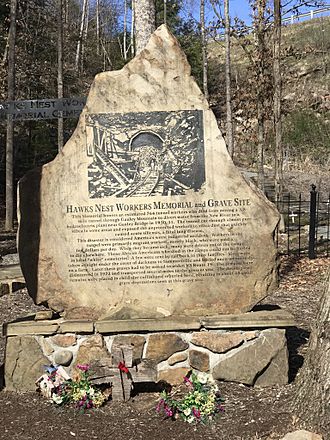Hawks Nest Tunnel disaster facts for kids

Historical marker "Hawks Nest Tunnel Disaster"
|
|
| Date | 1930–1935 |
|---|---|
| Location | Gauley Bridge, West Virginia |
| Cause | occupational silicosis |
| Deaths | 476 to 1,000 (estimated) |
The Hawks Nest Tunnel disaster was a terrible event that caused many workers to get a serious lung disease called silicosis. This happened during the building of the Hawks Nest Tunnel in West Virginia. It is known as one of the worst industrial disasters in American history.
Contents
Why Was the Tunnel Built?
To make electricity, a company called Union Carbide needed to move water from the New River. They decided to build a long tunnel to do this. This tunnel would carry the river's water under Gauley Mountain.
The tunnel was about 3 miles (4.8 km) long. It was built to send water to a power plant downstream. This project helped the company make more electricity.
Working Conditions and the Hidden Danger
Building the tunnel was very hard work. Around three thousand men, many of whom were Black, came to West Virginia to dig. They worked long hours, sometimes ten to fifteen hours a day. They used drills and dynamite to break through the rock.
The rock they were digging through was mostly sandstone, which contains a lot of silica dust. The workers were not given any masks or special equipment to protect their lungs. However, managers wore masks when they came to inspect the work.
What is Silicosis?
When workers breathed in the tiny silica dust particles, it damaged their lungs. This caused a serious lung disease called silicosis. Many workers became very sick, and some died quickly, even within a year.
How Many People Died?
It is hard to know exactly how many people died from the Hawks Nest Tunnel disaster. A historical marker at the site says 109 deaths were officially reported. However, a hearing in Congress suggested the number was 476.
Other sources believe the death toll was much higher, possibly between 700 and over 1,000 workers. Many of the workers were African-Americans who traveled from the southern United States. Some became sick and returned home, making it difficult to count everyone who died from the disease.
Remembering the Workers
There are special places to remember the workers who died. These memorials help us learn about this sad part of history.
Hawks Nest Workers Memorial and Grave Site
There is a memorial and grave site in Mount Lookout. It honors the many tunnel workers who died. The memorial explains that the tunnel went through rock that was almost pure silica. This caused a fatal lung disease for the unprotected workers.
Many of the workers were migrant workers, mostly Black. When they got sick, some were forced to leave the work camps. Those who died in the camps could not be buried in local "white" cemeteries. Some were buried on a farm in Summersville.
Later, these graves had to be moved when a road was made wider. In 1972, the remains were moved to the current memorial site. About 48 small grave markers can be seen there today. The memorial was officially opened on September 7, 2012.
Historical Marker at Hawks Nest State Park

There is also a historical marker at nearby Hawks Nest State Park. It explains that the tunnel construction led to West Virginia's worst industrial disaster. It mentions that silica rock dust caused many deaths among the workers. This tragedy helped people understand acute silicosis as a work-related lung disease. It also led to new laws to protect workers.
Images for kids




